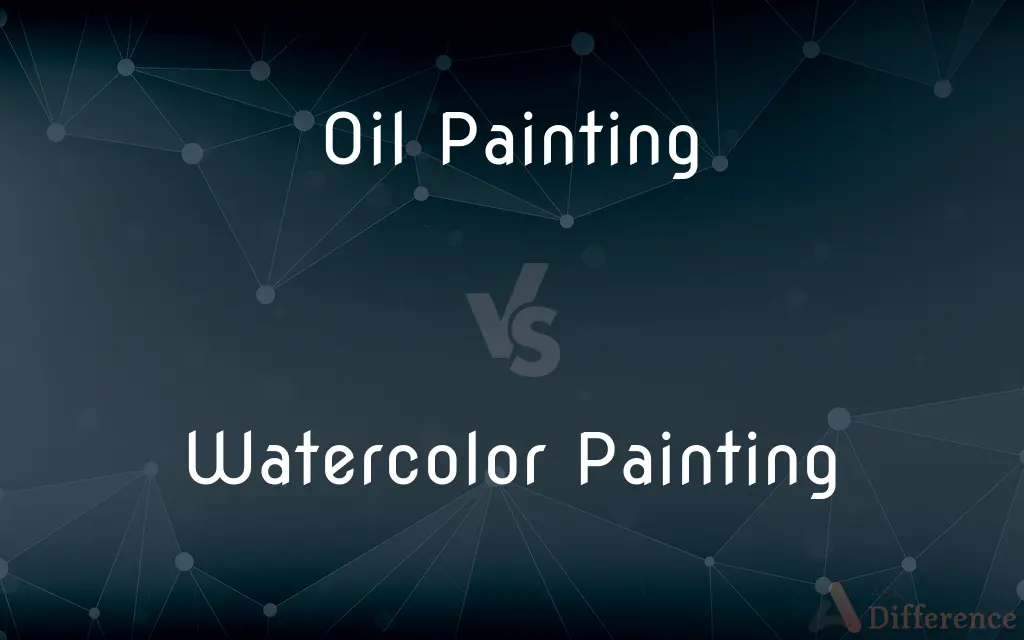Oil Painting vs. Watercolor Painting — What's the Difference?
Edited by Tayyaba Rehman — By Fiza Rafique — Published on November 8, 2023
Oil Painting uses slow-drying paint, allowing for rich texture and color blending. Watercolor Painting utilizes water-soluble paints, offering a translucent, delicate appearance and quicker drying times.

Difference Between Oil Painting and Watercolor Painting
Table of Contents
ADVERTISEMENT
Key Differences
Oil Painting is recognized for its vibrant, saturated colors that artists can manipulate for an extended period due to its slow drying nature. In contrast, Watercolor Painting is celebrated for its ability to create soft, light, and often ethereal visuals with a faster drying time, limiting prolonged manipulation of the paint once applied.
Artists using Oil Painting techniques often praise the medium's ability to retain brush or knife marks, allowing for expressive texture on the canvas. On the other side, Watercolor Painting provides a more fluid and diffused look, with colors that can bleed into one another, forming soft, undefined edges and unexpected interactions on the paper.
The medium of Oil Painting enables artists to build up layers, known as glazes, producing a luminous, rich color depth and creating three-dimensional effects. Whereas, Watercolor Painting demands a strategic approach to layering, usually from light to dark, as the transparency of the medium reveals all underlying layers, which can either enhance or muddy the final appearance.
Oil Painting can be applied to various surfaces, such as canvas, wood, or paper, as long as they are primed appropriately to handle the oil content. Conversely, Watercolor Painting primarily utilizes paper, specifically designed to withstand the application of water and maintain the paper's integrity during the painting process.
In terms of historical precedent, Oil Painting has been a prominent medium in the production of artworks that seek to demonstrate detail, depth, and vibrancy, particularly in portraiture and landscape. Watercolor Painting, while also utilized throughout history, is often associated with field studies and travel sketches due to its portability and quick-drying nature, lending itself to capturing transient moments in time.
ADVERTISEMENT
Comparison Chart
Medium Base
Oil
Water
Drying Time
Slow
Fast
Texture
Can be thick and textured
Generally smooth
Color Appearance
Often vibrant and opaque
Transparent and light
Commonly Used Surfaces
Canvas, wood
Special watercolor paper
Compare with Definitions
Oil Painting
Oil Painting can produce textural, three-dimensional visual effects.
He manipulated the brush to create dynamic textures in his Oil Painting.
Watercolor Painting
Watercolor Painting uses pigments dissolved in water.
Her Watercolor Painting displayed soft, merging hues.
Oil Painting
Oil Painting has been prominent in historical and classical artworks.
The gallery showcased a renaissance Oil Painting with impeccable detail.
Watercolor Painting
Watercolor Painting typically demands strategic layering techniques.
He meticulously planned each layer for his Watercolor Painting.
Oil Painting
Oil Painting allows for prolonged manipulation due to slow drying.
The artist revisited and adjusted the Oil Painting over several days.
Watercolor Painting
Watercolor Painting generally employs special watercolor paper.
The artist chose a high-quality paper for her Watercolor Painting.
Oil Painting
Oil Painting utilizes pigments suspended in oil.
The Oil Painting portrayed vivid, lifelike colors.
Watercolor Painting
Watercolor Painting is recognized for its transparent qualities.
The light shone through the delicate layers of the Watercolor Painting.
Oil Painting
Oil Painting is suitable for various primed surfaces.
She created her Oil Painting on a finely primed canvas.
Watercolor Painting
Watercolor Painting can create soft, fluid, and bleeding color effects.
The blue and yellow in the Watercolor Painting blended to create a gentle green.
Common Curiosities
What is oil painting?
Oil painting is a technique that uses pigments mixed with a medium of drying oil, such as linseed oil.
Is oil painting durable?
Yes, oil paintings can last for centuries if properly cared for.
What's the primary solvent for oil paints?
Turpentine or mineral spirits are commonly used to thin paints and clean brushes.
What surfaces are suitable for watercolor painting?
Watercolor paper, which is specifically designed to absorb water, is the most common surface.
How long does a watercolor painting take to dry?
Typically, it dries within minutes to hours, depending on the paper's absorbency and the amount of water used.
How long does an oil painting take to dry?
It can vary from days to weeks, depending on the thickness of the paint and environmental conditions.
What surfaces are suitable for oil painting?
Canvas (primed), wood, and masonite are commonly used. Linen canvas is often preferred for its texture and durability.
Are watercolors translucent?
Generally, yes. The water base allows for light to shine through the pigment, giving a luminescent effect.
Can you correct mistakes in watercolor painting?
To some extent. While it's difficult to cover mistakes due to the medium's transparency, some techniques can be used to lift or adjust colors.
Which is older, oil or watercolor painting?
Both techniques are ancient, but watercolor was used for sketches long before the development of modern oil painting in the Renaissance.
What is watercolor painting?
Watercolor painting uses pigments suspended in a water-based solution.
Can you mix oil and watercolor in one artwork?
Generally, it's challenging since oil repels water. However, artists might use watercolors for sketches and then paint over with oils.
Which medium is more forgiving for beginners?
Oil painting is often considered more forgiving because it dries slowly, allowing for corrections. However, the ease varies depending on personal preferences and specific techniques.
How are the brushes different for both techniques?
Oil painting brushes are typically stiffer to handle the paint's thickness, while watercolor brushes are softer to hold water.
Which one is more expensive to start with?
Oil painting can be pricier initially due to the cost of paints, mediums, and canvases. Watercolors might be more affordable, especially for beginners.
Share Your Discovery

Previous Comparison
Job Analysis vs. Job Evaluation
Next Comparison
Synapsis vs. Crossing OverAuthor Spotlight
Written by
Fiza RafiqueFiza Rafique is a skilled content writer at AskDifference.com, where she meticulously refines and enhances written pieces. Drawing from her vast editorial expertise, Fiza ensures clarity, accuracy, and precision in every article. Passionate about language, she continually seeks to elevate the quality of content for readers worldwide.
Edited by
Tayyaba RehmanTayyaba Rehman is a distinguished writer, currently serving as a primary contributor to askdifference.com. As a researcher in semantics and etymology, Tayyaba's passion for the complexity of languages and their distinctions has found a perfect home on the platform. Tayyaba delves into the intricacies of language, distinguishing between commonly confused words and phrases, thereby providing clarity for readers worldwide.












































